Reflections from a light-sensitive process
Sharing thoughts from a recent taster workshop that draws from the Deepening Creative Practice with organisations programme.
We had received a request from Alexandra Gerny of the Alumni Association of ‘Coaching and Consulting in Context’ at Utrecht University, Netherlands, asking if we could offer a taste of the Tavistock Institute’s seasonal, co-created curated programme, Deepening Creative Practice (DCP). A challenging request which we were delighted to take up.
We selected some core aspects and aesthetics of the programme to guide the design of the workshop:
- working with artists; Sam Nightingale and Juliet Scott.
- working with overarching curatorial themes as we do in DCP seasons, choosing Letting Go and Transformation, which we worked with in Winter.
- working with systems psychodynamics, particularly paying attention to parallel processes of material transformation and image-making.
- taking a curatorial journey towards showing and revealing the process;
- supporting participants in weaving these elements together towards unexpected outcomes and in making associations to their practice with organisations.
Sam’s reflections were of processes of transformation and how we are implicated in things we don’t yet know about. He writes about preparing for the workshop.
I’m in my studio, it’s dark outside, and my workbench is illuminated by the dull glow of an old tungsten lamp. I am mixing chemicals to use in an archaic photographic process. I stir a few grams of ferric ammonium citrate into water. I mix a few grams of potassium ferricyanide with water in another container. When these two solutions meet, a little bit of magic happens – they become light sensitive. It’s a process that makes me feel a little like an alchemist – harnessing the power of unknown forces to bring about change and transmutation. On my workbench, a stack of paper sits ready for coating. Sheet by sheet, I carefully paint the light-sensitive solution across the paper’s surface, moving each sheet to the drying rack before I coat the next. I am preparing the paper for making cyanotypes, one of the oldest forms of photographic printmaking.
These sensitised pieces of paper will leave my London studio and be posted to The Netherlands for a workshop. It’s a process that proves to be more complex than it would have been pre-Brexit. The workshop participants know nothing yet of this (invisible) process that has already begun. However, they are already embroiled – without their knowledge. As each participant receives the unexpected package of light-sensitive paper through their letterbox and reads the cryptic message ‘DO NOT OPEN IN THE LIGHT’, and the instructions ‘gather objects from nature and your workspace’, it easy to imagine that feeling of confusion, frustration, uncertainty and maybe even some anger could arise. Perhaps it’s a process that mirrors the experience of much of organisational life, where we arrive in situations without full knowledge of the dynamics and stories that have brought us there. These sensitised pieces of paper will play an essential role in the workshop; they are the ground for latent images (invisible images awaiting development) to emerge, of the unknown and yet to be revealed. The cyanotypes become containers for anticipation, fear, excitement, hope, delight and even disappointment.
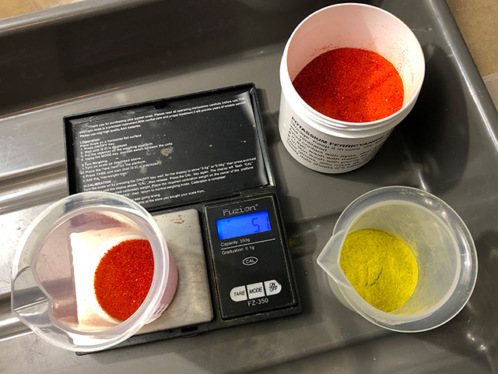
Image: Sam Nightingale
Alexandra’s (AVCCC) reflections were of expectations of visualising the multiple factors that impact transformational processes, about opening up to their influence in creative processes with organisations.
The one thing I did not expect from the workshop ‘Infra-sensing …’ was relief. I started the afternoon as I start so many things: I wanted to do it well. I wanted to create beautiful cyanotypes. I wondered whether I would hang them on the wall in my office; I dreamt of suddenly discovering that I am not such a bad artist after all.
What actually happened – I placed my objects on the light-sensitive paper, having ideas about what might work well and what might not work. I was wrong. The objects did play a role but not a very big one. So many other influences were at play – light, time, wind and more. My nice heaps of salt – were not visible in the end result. My hope of shadows – not there. My carelessly thrown grass – that looked actually quite nice.
For me, the cyanotypes became a metaphor for our work as coaches and consultants:
- There is so much more than just our efforts that influence any given situation. Wanting to do it well does not make the result better. Actually, it makes it worse. Well, I knew that, but, oh, how is it hard to remember, to act according to this insight! How is it hard to let go of hopes for or feelings of omnipotence!
- Even though I did not know in the beginning what I was doing, a lot happened. Not knowing is so hard to bear, and it opens up so many possibilities.
- Many of us were going for the beautiful, the nice. I do, groups do. But it is about owning the ugly. Is it ugly?
The workshop put many things back into perspective – what a relief. The cyanotypes will keep reminding me.
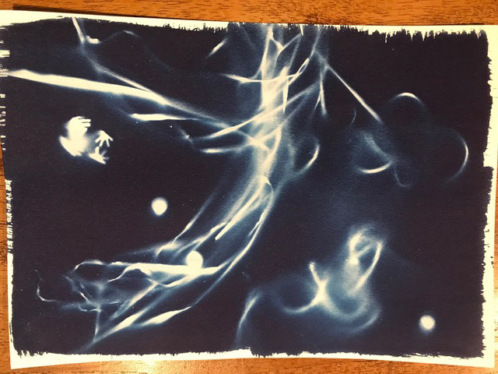
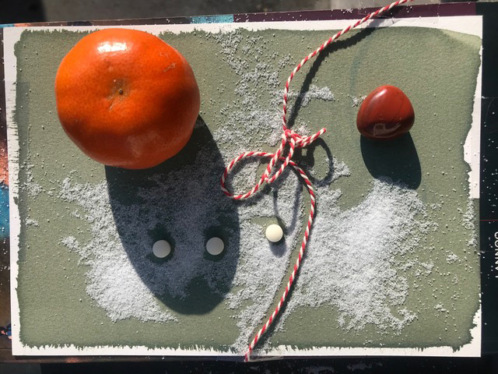
Images: Alexandra Gerny
Gill Wijnhoven’s (AVCCC) reflections speak to a bucolic but tainted scene like Pieter Breughel’s winter paintings of ice skaters. Like the pictures, she finds other emotions beneath the surface or backstage in the workshop.
Two things keep coming back when I think about the workshop.
One is the joy that seemed to permeate the afternoon. The Netherlands was frozen and sunny. Some participants had spent the morning out ice skating, and people were looking forward to more icy fun. As if the day had been curated for us. The feeling was almost over the top. I was conscious of talking in absolute terms: ‘everyone is so happy’ when I know that can’t be true. I know some people hate ice and snow and are scared of skating. I know that some people were a bit anxious about creating the cyanotypes. I had my own anxious moment when asked to ‘tell the story’ of my cyanotype. What story? I can’t do this. I was blocked.
The second is the Stephen Covey phrase ‘begin with the end in mind’. I started making my cyanotypes convinced that what I had envisaged would emerge, despite Sam’s realistic tales of his own experiences. I didn’t get anywhere near my hope, as we so often don’t in work. I wanted to see all the detail of my dried oranges, and I got the outlines, which brought new associations. ‘The end’ I’d had in mind turned out to be a different place. I wasn’t exactly disappointed; I was more filled with ideas about what to try next. My ‘story’ was one of high expectations dashed, and of the sometimes tough work of looking at what the process actually reveals.
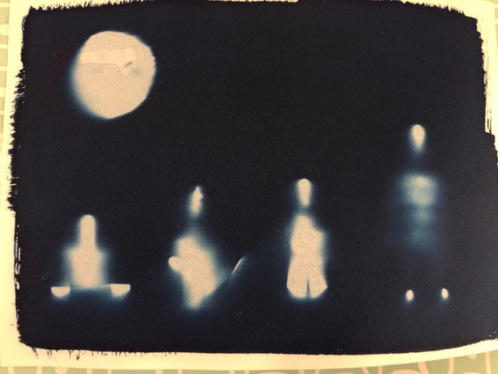
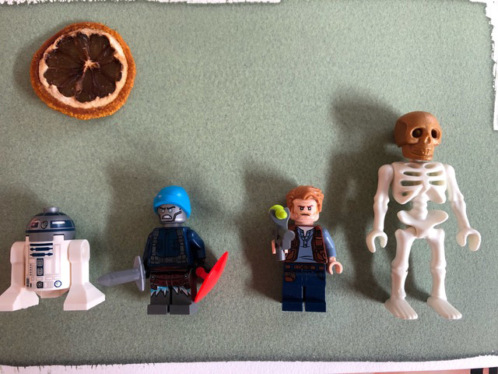
Images: Gill Wijnhoven
Juliet’s reflections on organising and curating
As I bridge the roles of artist, curator and organisational consultant, I ask for what purpose I grapple with their integration both in me and in working with organisations. I am slowly finding it is about paying deep attention to aesthetic criteria. And this isn’t to idealise certain organisational forms but more a reference to sensual qualities and getting into the viscerality, the pain, the shapes and surfaces of our social systems. I notice the highly tuned way that Sam finds himself the sorcerer in an alchemical process. His coated paper becomes a container of a multitude of feelings – guardian to a latent, becoming image – and how Alexandra and Gill pick this up and the many feelings and associations they play with and are haunted by. How through this process, they reach a different sense of transformation than they had anticipated and find themselves able to let go of outcomes they are working with in their wider practice.
Deepening Creative Practice with Organisation will now be starting in Autumn 2021 and are inviting applications.
If you would like to receive a brochure or would like to speak to one of the programme Directors, please email reception@tavinstitute.org


